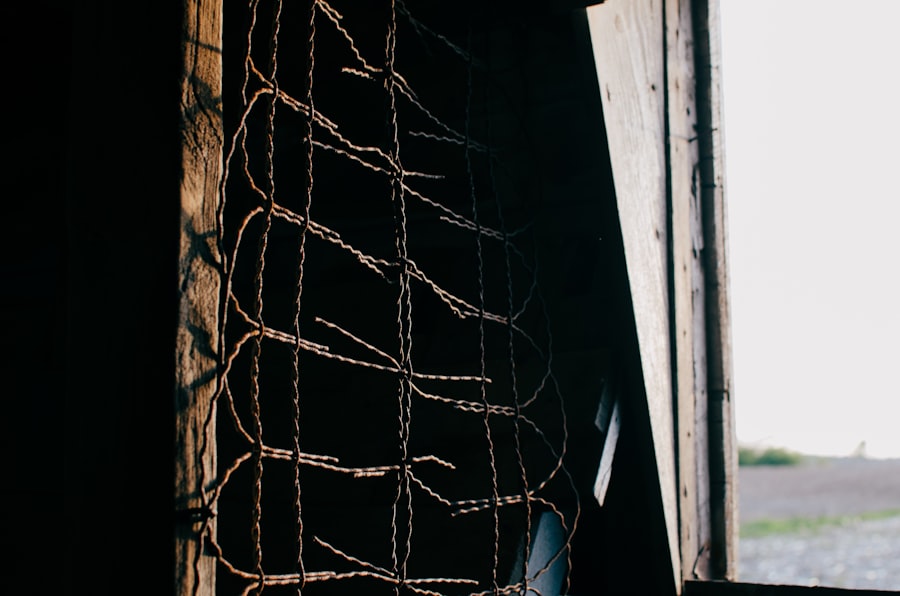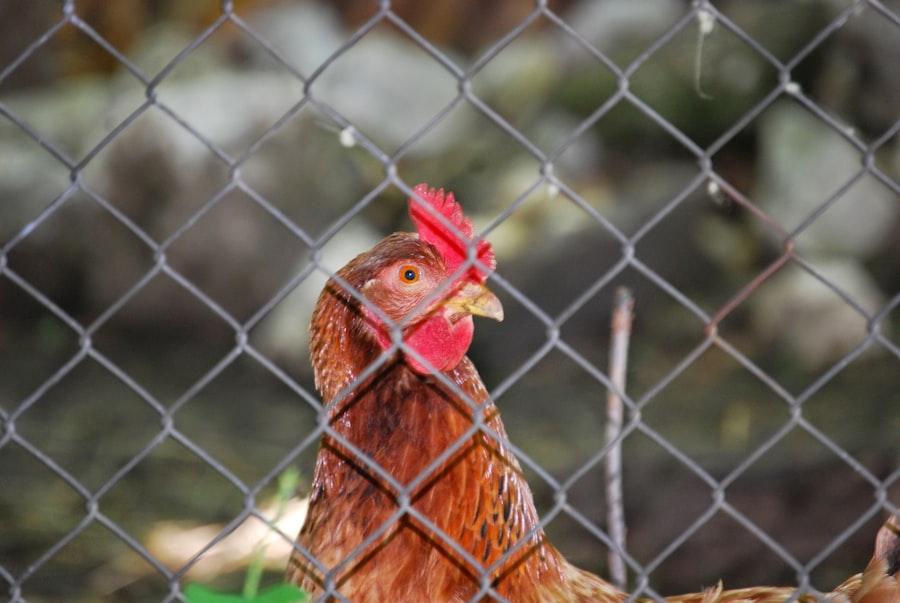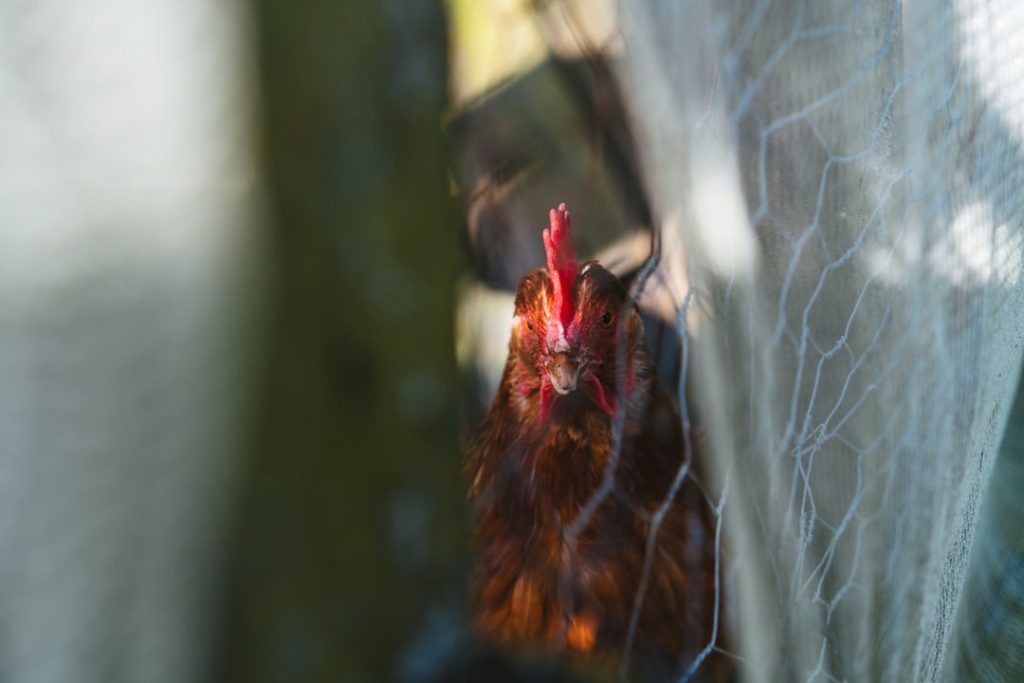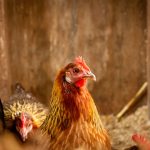Fencing is a critical element in chicken husbandry, serving multiple essential functions. Primarily, it acts as a protective barrier against predators such as foxes, raccoons, and birds of prey, which pose significant threats to poultry. Simultaneously, fencing prevents chickens from straying into potentially hazardous areas or becoming lost.
The importance of fencing extends beyond physical protection. It plays a crucial role in maintaining biosecurity within the chicken enclosure. By restricting access to wild birds and other animals, fencing helps prevent the introduction of diseases and parasites that could harm the flock.
This aspect is particularly vital for commercial poultry operations, where disease outbreaks can have severe economic consequences. Avian influenza is one example of a disease that proper fencing can help mitigate by limiting contact between domestic poultry and wild birds. Effective fencing contributes to the overall health and well-being of the flock by creating a controlled environment that reduces the risk of disease transmission.
In summary, fencing is an indispensable component of responsible chicken keeping. It provides essential protection from predators, helps maintain biosecurity, and creates a safe, contained space for chickens to live and thrive. Investing in quality fencing is a fundamental step in ensuring the safety and health of a poultry flock.
Table of Contents
- 1 Types of Fencing Materials for Chicken Enclosures
- 2 Tips for Installing and Maintaining Chicken Fencing
- 3 How to Choose the Right Height and Size for Chicken Fencing
- 4 Common Challenges and Solutions for Chicken Fencing
- 5 Integrating Chicken Fencing with Other Coop Security Measures
- 6 The Benefits of Properly Secured Chicken Fencing for Both Chickens and Owners
- 7 FAQs
- 7.1 What are the benefits of using fences to keep chickens in?
- 7.2 What types of fences are suitable for keeping chickens in?
- 7.3 How high should a fence be to keep chickens in?
- 7.4 What are some important considerations when installing a fence for chickens?
- 7.5 Are there any regulations or restrictions on fencing for chickens?
Key Takeaways
- Proper fencing is crucial for keeping chickens safe from predators and ensuring their security.
- Common fencing materials for chicken enclosures include wire mesh, electric fencing, and hardware cloth.
- Regular maintenance and proper installation are essential for ensuring the effectiveness of chicken fencing.
- The right height and size of chicken fencing depend on the size and breed of the chickens, as well as the potential threats in the area.
- Common challenges with chicken fencing include predators digging under or climbing over the fence, which can be addressed with reinforced fencing and predator-proofing measures.
Types of Fencing Materials for Chicken Enclosures
Popular Fencing Materials for Chicken Enclosures
When it comes to selecting fencing materials for chicken enclosures, poultry owners have several options to choose from. The most common types of fencing materials used for chicken enclosures include wire mesh, hardware cloth, electric fencing, and wooden or metal posts. Wire mesh and hardware cloth are popular choices for creating a physical barrier around the chicken coop and outdoor run.
Benefits of Each Fencing Material
Wire mesh and hardware cloth are durable, long-lasting, and provide excellent protection against predators such as foxes and raccoons. Electric fencing is another effective option for deterring predators, as it delivers a mild electric shock to any animal that comes into contact with it. In addition to these options, wooden or metal posts can be used to support and reinforce the fencing material, providing stability and strength to the fence.
Factors to Consider When Choosing Fencing Materials
When selecting fencing materials for chicken enclosures, it is essential to consider factors such as durability, ease of installation, and cost. Poultry owners should choose materials that are suitable for their specific needs and budget, while also providing the necessary level of protection for their flock. By carefully evaluating their options, poultry owners can determine the best fencing material for their chicken enclosure.
Tips for Installing and Maintaining Chicken Fencing

Proper installation and maintenance of chicken fencing are essential for ensuring the safety and security of the flock. When installing fencing around a chicken coop and outdoor run, it is important to ensure that the fence is securely anchored to the ground to prevent predators from digging underneath it. Additionally, all seams and connections should be tightly secured to prevent any gaps or weak points that could compromise the integrity of the fence.
Regular inspections should be conducted to check for any signs of wear or damage, and repairs should be made promptly to maintain the effectiveness of the fencing. Furthermore, maintaining the area around the fence is also important for preventing potential security breaches. Keeping vegetation trimmed back from the fence line can help to deter predators from using it as cover to approach the enclosure.
Additionally, removing any debris or clutter from around the fence can help to prevent potential entanglements or obstructions that could compromise its effectiveness. By following these tips for installing and maintaining chicken fencing, poultry owners can ensure that their flock remains safe and secure within their enclosure. In conclusion, proper installation and maintenance of chicken fencing are crucial for ensuring the safety and security of the flock.
Poultry owners should take care to securely anchor the fence, conduct regular inspections, make prompt repairs as needed, and maintain the area around the fence to prevent potential security breaches.
How to Choose the Right Height and Size for Chicken Fencing
Choosing the right height and size for chicken fencing is essential for providing adequate protection for the flock. The height of the fence should be tall enough to prevent predators from jumping or climbing over it, while also allowing enough space for chickens to move freely within the enclosure. A general rule of thumb is to have a fence that is at least 6 feet tall to deter most predators such as foxes and raccoons.
However, in areas with larger predators such as coyotes or bears, taller fencing may be necessary. In addition to height, the size of the fencing enclosure should also be carefully considered. The outdoor run should provide enough space for chickens to roam and forage comfortably, while also allowing room for any additional structures such as dust baths or shelters.
Poultry owners should take into account the number of chickens in their flock and plan accordingly to ensure that the enclosure is adequately sized to meet their needs. In summary, choosing the right height and size for chicken fencing is crucial for providing adequate protection for the flock. Poultry owners should consider factors such as predator pressure in their area, the number of chickens in their flock, and available space when determining the appropriate dimensions for their fencing enclosure.
Common Challenges and Solutions for Chicken Fencing
While chicken fencing is an effective means of protecting the flock, there are common challenges that poultry owners may encounter when using this security measure. One common challenge is predators digging underneath the fence to gain access to the enclosure. To address this issue, owners can bury hardware cloth or wire mesh along the perimeter of the fence to create an underground barrier that prevents digging.
Another challenge is predators such as raccoons or birds of prey reaching through the fence to grab chickens. To prevent this, owners can install an overhang or apron on the top of the fence to create a barrier that deters predators from reaching over it. Additionally, regular inspections and maintenance can help to identify and address any potential weak points in the fence before they become a problem.
In conclusion, while there are common challenges associated with chicken fencing, there are also effective solutions available to address them. By taking proactive measures such as burying wire mesh underground and installing an overhang on the fence, poultry owners can mitigate potential security risks and ensure the safety of their flock.
Integrating Chicken Fencing with Other Coop Security Measures

Motion-Activated Lights and Alarms
Installing motion-activated lights or alarms around the perimeter of the enclosure can deter nocturnal predators such as raccoons or foxes. These devices can help to alert owners to potential threats and discourage predators from approaching the enclosure.
Guard Animals
Using guard animals such as dogs or geese is another effective security measure to protect the flock from predators. These animals can help to deter potential threats and provide an additional layer of security for the chickens.
Secure Latches and Locks
Implementing secure latches and locks on coop doors and windows can help to prevent unauthorized entry by predators or other animals. This added layer of security can provide peace of mind for poultry owners.
Comprehensive Security System
In summary, integrating chicken fencing with other coop security measures such as motion-activated lights, guard animals, and secure latches can provide added protection for the flock. By combining these measures, poultry owners can create a comprehensive security system that helps to keep their chickens safe and secure.
The Benefits of Properly Secured Chicken Fencing for Both Chickens and Owners
Properly secured chicken fencing offers numerous benefits for both chickens and their owners. For chickens, it provides a safe and secure environment where they can roam freely without fear of predation. This allows them to exhibit natural behaviors such as scratching, pecking, and dust bathing, which are essential for their physical and psychological well-being.
Additionally, secure fencing helps to prevent injuries or loss due to wandering into hazardous areas or encountering predators. For owners, properly secured chicken fencing provides peace of mind knowing that their flock is protected from harm. It also helps to maintain biosecurity within the enclosure by preventing the entry of wild birds or animals that may carry diseases or parasites.
Furthermore, by creating a safe environment for their chickens, owners can enjoy greater productivity from their flock and a higher quality of eggs or meat. In conclusion, properly secured chicken fencing offers numerous benefits for both chickens and their owners. It provides a safe and secure environment for chickens to thrive while offering peace of mind and productivity for poultry owners.
By investing in quality fencing and implementing proper security measures, poultry owners can create a healthy and thriving environment for their feathered friends.
If you’re looking for tips on keeping chickens in your garden, you might also be interested in learning about the mating season for turkeys. Understanding the breeding habits of different poultry can help you create a safe and secure environment for your birds. Check out this article on mating season for turkeys for more information.
FAQs
What are the benefits of using fences to keep chickens in?
Fences provide a physical barrier to keep chickens contained in a specific area, preventing them from wandering off or getting into areas where they shouldn’t be. They also offer protection from predators and can help to maintain a clean and organized space for the chickens.
What types of fences are suitable for keeping chickens in?
Chicken wire, hardware cloth, electric netting, and wooden or metal fencing are all suitable options for keeping chickens contained. The type of fence chosen will depend on factors such as the size of the chicken coop, the terrain of the area, and the presence of predators.
How high should a fence be to keep chickens in?
The height of a fence to keep chickens in will depend on the breed of chickens and their ability to fly. In general, a fence should be at least 6 feet high to prevent most chicken breeds from flying over it. However, for particularly flighty breeds, a taller fence may be necessary.
What are some important considerations when installing a fence for chickens?
When installing a fence for chickens, it’s important to consider the strength and durability of the materials, the need for predator protection, and the ability to withstand weather conditions. Additionally, the fence should be properly secured to the ground to prevent predators from digging underneath it.
Are there any regulations or restrictions on fencing for chickens?
Regulations and restrictions on fencing for chickens can vary depending on local ordinances and homeowners’ association rules. It’s important to check with local authorities and any relevant governing bodies to ensure that the chosen fencing complies with any applicable regulations.
Meet Walter, the feathered-friend fanatic of Florida! Nestled in the sunshine state, Walter struts through life with his feathered companions, clucking his way to happiness. With a coop that’s fancier than a five-star hotel, he’s the Don Juan of the chicken world. When he’s not teaching his hens to do the cha-cha, you’ll find him in a heated debate with his prized rooster, Sir Clucks-a-Lot. Walter’s poultry passion is no yolk; he’s the sunny-side-up guy you never knew you needed in your flock of friends!








